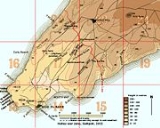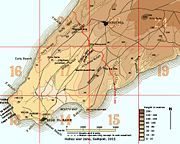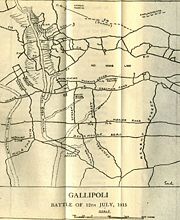
Battle of Gully Ravine
Encyclopedia
The Battle of Gully Ravine (Zığındere) was a World War I
World War I
World War I , which was predominantly called the World War or the Great War from its occurrence until 1939, and the First World War or World War I thereafter, was a major war centred in Europe that began on 28 July 1914 and lasted until 11 November 1918...
battle fought at Cape Helles
Cape Helles
Cape Helles is the rocky headland at the south-westernmost tip of the Gallipoli peninsula, Turkey. It was the scene of heavy fighting between Turkish and British troops during the landing at Cape Helles at the beginning of the Gallipoli Campaign in 1915....
on the Gallipoli
Gallipoli
The Gallipoli peninsula is located in Turkish Thrace , the European part of Turkey, with the Aegean Sea to the west and the Dardanelles straits to the east. Gallipoli derives its name from the Greek "Καλλίπολις" , meaning "Beautiful City"...
peninsula. By June 1915 all thoughts the Allies had of a swift decisive victory over the Ottoman Empire
Ottoman Empire
The Ottoman EmpireIt was usually referred to as the "Ottoman Empire", the "Turkish Empire", the "Ottoman Caliphate" or more commonly "Turkey" by its contemporaries...
had vanished. The preceding Third Battle of Krithia
Third Battle of Krithia
The Third Battle of Krithia , fought on the Gallipoli peninsula during World War I, was the final in a series of Allied attacks against the Ottoman defences aimed at capturing the original objectives of 25 April 1915...
and the attack at Gully Ravine had limited objectives and had much in common with the trench warfare
Trench warfare
Trench warfare is a form of occupied fighting lines, consisting largely of trenches, in which troops are largely immune to the enemy's small arms fire and are substantially sheltered from artillery...
prevailing on the Western Front
Western Front (World War I)
Following the outbreak of World War I in 1914, the German Army opened the Western Front by first invading Luxembourg and Belgium, then gaining military control of important industrial regions in France. The tide of the advance was dramatically turned with the Battle of the Marne...
. Unlike previous Allied attacks at Helles, the Gully Ravine action was largely successful at achieving its objectives though at a typically high cost in casualties.
Prelude

France
The French Republic , The French Republic , The French Republic , (commonly known as France , is a unitary semi-presidential republic in Western Europe with several overseas territories and islands located on other continents and in the Indian, Pacific, and Atlantic oceans. Metropolitan France...
contingent were confronted by a number of strong Ottoman redoubts on Kereves Spur. As a prelude to a new offensive the commander at Helles, Lieutenant General
Lieutenant General
Lieutenant General is a military rank used in many countries. The rank traces its origins to the Middle Ages where the title of Lieutenant General was held by the second in command on the battlefield, who was normally subordinate to a Captain General....
Aylmer Hunter-Weston
Aylmer Hunter-Weston
Lieutenant-General Sir Aylmer Gould Hunter-Weston KCB DSO GStJ was a British Army general who served in World War I at Gallipoli and the Somme Offensive...
ordered separate limited attacks to advance the flanks.
(1. Kerevizdere Battle)On 21 June the French, with overwhelming artillery
Artillery
Originally applied to any group of infantry primarily armed with projectile weapons, artillery has over time become limited in meaning to refer only to those engines of war that operate by projection of munitions far beyond the range of effect of personal weapons...
support, attacked two redoubts controlling the crest of Kereves Spur (Kervizdere). Over 40,000 shells fell on the Ottoman 2nd Division defending this area. They succeeded in capturing Haricot Redoubt but the second objective, the Quadrilateral, was not captured until 30 June. Captain Kemal Bey commanding the troops from the line of fire was wounded and died the next day. The French suffered 2,500 casualties but the Ottomans on the receiving end of the bombardment suffered 6,000. Remnants of the Ottoman 2nd Division were pulled back to the Asian side after this battle. This minor gain was cause of much celebration for allies who were at that point very anxious for any good news. General Gourard received congratulatory telegrams from London and Paris, Lord Kitchener, Admiral Robeck, and General Hamilton. Colonel Girdon was awarded with Légion d'honneur
On 28 June a similar attack was planned for the left flank along Gully Spur, Gully Ravine and neighbouring Fir Tree Spur. The terrain around Gully Ravine (Turkish
Turkish language
Turkish is a language spoken as a native language by over 83 million people worldwide, making it the most commonly spoken of the Turkic languages. Its speakers are located predominantly in Turkey and Northern Cyprus with smaller groups in Iraq, Greece, Bulgaria, the Republic of Macedonia, Kosovo,...
: Sığındere) was closer to the wild and rough terrain at Anzac Cove
Anzac Cove
Anzac Cove is a small cove on the Gallipoli peninsula in Turkey. It became famous as the site of World War I landing of the ANZAC on April 25, 1915. The cove is a mere long, bounded by the headlands of Ari Burnu to the north and Little Ari Burnu, known as Hell Spit, to the south...
than to the ground elsewhere at Helles. The plan was for the British 29th Division
British 29th Division
The British 29th Division, known as the Incomparable Division, was a First World War regular army infantry division formed in early 1915 by combining various units that had been acting as garrisons about the British Empire. Under the command of Major General Aylmer Hunter-Weston, the division...
and the 29th India
India
India , officially the Republic of India , is a country in South Asia. It is the seventh-largest country by geographical area, the second-most populous country with over 1.2 billion people, and the most populous democracy in the world...
n Brigade to attack along Gully Spur and the ravine while one newly arrived brigade on loan to the 29th Division, the 156th Brigade from the British 52nd (Lowland) Division
British 52nd (Lowland) Division
The British 52nd Division was a Territorial Army division that was originally formed as part of the Territorial Force in 1908.- World War I :...
, would attack along Fir Tree Spur.
The battle
After two days of heavy bombardment, battle began at 10.45 am on 28 June with a preliminary raid to capture the BoomerangBoomerang
A boomerang is a flying tool with a curved shape used as a weapon or for sport.-Description:A boomerang is usually thought of as a wooden device, although historically boomerang-like devices have also been made from bones. Modern boomerangs used for sport are often made from carbon fibre-reinforced...
Redoubt on Gully Spur. The general advance commenced shortly afterwards. The artillery fire on Gully Spur was overwhelming and the 2/10th Battalion of the Gurkha Rifles
Gurkha Rifles
Gurkha Rifles may refer to any of a number of regiments of Gurkhas:* 1st King George V's Own Gurkha Rifles * 2nd King Edward VII's Own Gurkha Rifles * 3rd Queen Alexandra's Own Gurkha Rifles...
and the 2nd Battalion of the Royal Fusiliers advanced rapidly a distance of half a mile to a point named "Fusilier Bluff" which was to become the northern-most Allied position at Helles.
In the ravine the 1st Battalion of The Border Regiment did not advance as far as those troops on the spur since Ottomans there were somewhat sheltered from the deadly bombardment from the sea. Their final position was fortified with rocks and boulders and became known as "Border Barricade".
On the right of the advance, along Fir Tree Spur, the battle did not go so well for the British. The inexperienced soldiers of the 156th Brigade lacked artillery support and were massacred by Ottoman machine gun
Machine gun
A machine gun is a fully automatic mounted or portable firearm, usually designed to fire rounds in quick succession from an ammunition belt or large-capacity magazine, typically at a rate of several hundred rounds per minute....
s and bayonet attacks. Despite the opposition, they were ordered to press the attack and so the support and reserve lines were sent forward but made no progress. By the time the attack was halted the Brigade was at half strength, having suffered 1,400 casualties of which 800 had been killed. Some battalions were so depleted they had to be merged into composite formations. When the rest of the 52nd Division landed, the commander, Major General
Major General
Major general or major-general is a military rank used in many countries. It is derived from the older rank of sergeant major general. A major general is a high-ranking officer, normally subordinate to the rank of lieutenant general and senior to the ranks of brigadier and brigadier general...
Granville Egerton, was enraged at the manner in which his 156th Brigade had been sacrificed.
The Counter-Attacks
Ottoman commanders were very concerned about this advance near the Western coast of Gallipoli which threatened to encircle their right wing. Gully Ravine became the scene of vicious and bloody fighting as the Ottomans commenced a series of counter-attacks on the night of 1/2 July. Two soldiers of the 1st Battalion, the Royal Inniskilling FusiliersRoyal Inniskilling Fusiliers
The Royal Inniskilling Fusiliers was a Irish infantry regiment of the British Army formed in 1881 by the amalgamation of the 27th Regiment of Foot and the 108th Regiment of Foot...
, Captain Gerald O'Sullivan
Gerald Robert O'Sullivan
Gerald Robert O'Sullivan VC was an Irish recipient of the Victoria Cross, the highest and most prestigious award for gallantry in the face of the enemy that can be awarded to British and Commonwealth forces.He was 26 years old, and a captain in the 1st Battalion, Royal Inniskilling Fusiliers,...
and Corporal James Somers
James Somers
James Somers VC was an Irish recipient of the Victoria Cross, the highest and most prestigious award for gallantry in the face of the enemy that can be awarded to British and Commonwealth forces.-Biography:...
, were awarded the Victoria Cross
Victoria Cross
The Victoria Cross is the highest military decoration awarded for valour "in the face of the enemy" to members of the armed forces of various Commonwealth countries, and previous British Empire territories....
for recapturing a trench taken by the Ottomans during a counter-attack.
Faik Paşa, known for his bravery and aggressiveness was put in charge of the right wing of the Otto limanne at Sıĝındere.
The Ottomans, with plentiful manpower in reserve but lacking any significant artillery and machine guns, made incessant counter-attacks culminating with the strongest on 5 July but all were repulsed. Still, the control of the strategic hills overlooking Sıgındere and Kerevizdere were denied to the Allies by massive Ottoman bayonet attacks. The Ottoman casualties for the period between 28 June and 5 July are estimated at between 14,000 and 16,000, four times the British losses. Where possible the Ottoman dead were burned but a truce to bury them was refused. The British believed the dead bodies were an effective barrier and that Ottoman soldiers were unwilling to attack across them. This was one of the few truly unvalorous and unmagnanimous acts committed by Allies which infuriated the Ottoman greatly.
In the face of immense losses, Faik Paşa had stopped first the counter attack on the morning of 30 June. In spite of strong and direct urging from Liman Paşa (Otto Liman von Sanders
Otto Liman von Sanders
Generalleutnant Otto Liman von Sanders was a German general who served as adviser and military commander for the Ottoman Empire during World War I.-Biography:...
) and pressure to continue the counter-attack, he wanted to rest his badly decimated troops for a day. Hesitation of Faik Paşa unnerved Weber Paşa who was in command of the front there. He contemplated pulling back behind the ever strategic Alçı Tepe as a last resort. This would have given over complete victory to the Allies. He had to be strongly dissuaded by Liman Paşa.
Finally, the Ottoman 1st Division led by Lieutenant Colonel (Kaymakam) Cafer Tayyar Bey
Cafer Tayyar Eğilmez
Cafer Tayyar Eğilmez was an officer of the Ottoman Army and the general of the Turkish Army.-External lınks:* Zülal Keleş, , Atatürk Araştırma Merkezi Dergisi, Sayı 44, Cilt: XV, Temmuz 1999....
commenced another counterattack at 18:00 on 2 July. Again, though they reached within 30m of the British trenches, the losses were unbearable. Men were melting away in front of rows of machine guns. Attack continued whole night. Eventually Faik Paşa ordered them to dig in and take defensive posture. Liman Paşa immediately released him and assigned Mehmet Ali Paşa in his place. As soon as the 3. Division which had just crossed the Narrows and arrived at the lines around midnight, Mehmet Ali Paşa ordered them to attack 3:45 am. Liman Paşa agreed to delay the attack for 24 hours only after a Major Eggert on the staff of Mehmet Ali Paşa personally appealed to him.
Meanwhile the Allies had observed the preparation for the attack from the air and made their own preparations. On 5 July the last major attack of this battle commenced but met with a very strong wall of fire the Allies put up. The dead were mounting again in front of the British trenches. Mehmet Ali Paşa staff were of the opinion that the Allied advance was already halted and there was no need for these heavy losses. Mehmet Ali Paşa, in fear of a reaction from Liman Paşa, who was in turn initimidated by Enver Paşa hesitated. Again, Major Eggert intervened and Liman Paşa yielded. Finally the slaughter was stopped. This was the bloodiest episode in the entire campaign.
After the counter-attacks ceased, the front line stabilised and remained largely static for the rest of the Gallipoli campaign although both sides engaged in a vigorous mining war around the ravine.
Achi Baba Nullah (2. Kerevizdere Battle)

The plan was for one brigade to attack in the morning and the other to attack in the afternoon so that the full weight of artillery support could be lent to each brigade. The 155th Brigade would attack at 7.35 am and the 157th at 4.50 pm. Bombardment began at 4:30 am, from land, sea and air. 14 Allied planes participated in softening up the Ottoman defenses, one of the first such combined actions in military history.
Both attacks began well with the capture of the first Ottoman trench but descended into chaos and confusion as, in a repeat of the April and May Helles battles, the troops advanced too far, lost contact and came under artillery and machine gun fire. The next morning confusion and panic resulted in a disorderly retreat which was eventually halted but Hunter-Weston ordered the advance to resume and sent the battered Royal Naval Division in again. They suffered a further 600 casualties on this occasion but the line was stabilised.
By the end of the battle, one third of the 52nd Division had become casualties. General Egerton was temporarily dismissed from his command of the division for protesting at the treatment of his troops.
Aftermath
In late June General Hunter-Weston departed his command of the British VIII Corps, suffering some indeterminate ailment. This marked the end of Helles as the main front at Gallipoli. The British attempted no more major offensives there for the remainder of the campaign. Weber Paşa, having lost Liman Paşa's confidence was sent back to Germany. The fighting now concentrated along the Sari Bair range and at a new landing at Suvla. In support of this new offensive in August, a diversionary attack was made at Helles which resulted in heavy fighting around Krithia VineyardBattle of Krithia Vineyard
The Battle of Krithia Vineyard was intended as a minor British action at Helles on the Gallipoli peninsula to divert attention from the imminent launch of the August Offensive. Instead, the British commander, Brigadier General H.E...
. Helles was finally evacuated on 8 January 1916.

